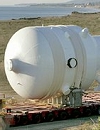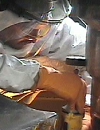Safety
IAEA has issued document on analysis and modelling of severe accidents for liquid metal fast reactors
IAEA is ready to send its specialists to the Kursk NPP, if necessary - Grossi
IAEA Board of Governors will hold an extraordinary meeting due to the attacks on the Zaporozhye NPP
Severe frosts did not affect the stable operation of Russian nuclear power plants
Iran has denied allegations of Araks river contamination
There have been no failures in the operation of nuclear power plants after a series of powerful earthquakes in Japan
Akkuyu NPP project employees collect help for earthquake victims
Russia creates reserve source of energy supply for Zaporozhye NPP
IAEA has published nuclear safety and security glossary
There are questions about the plans for the vitrification of radwastes in Hanford
The Firefighters of AKKUYU NUCLEAR JSC were Awarded for Their Professionalism
IAEA published pocket guide for medical physicists supporting response to a nuclear or radiological emergency
WANO calls on industry to build on progress after post-Fukushima improvements
The fourth unit of Leningrad NPP shutdown for a short-term repair
A statement could replace Swiss amendment to convention on nuclear safety
Japan begins the discussion of plans for creating a command bunkers on NPP
Kozloduy-6 unloaded to 50%
Kursk NPP: reduced power of unit No. 3
The incident at Leningrad NPP did not affect radiation safety
No American fuel in Zaporozhye NPP
Balakovo-2 is connected to the grid after shutdown
The sixth unit of Zaporizhzhya NPP is connected to the network after a fault
Mobile generators were tested at Dukovany NPP
The IAEA experts confirmed the commitment of Kola NPP to continuous operational safety improvement
Short circuit at forty kilometers from the Kursk NPP had no impact on plant operation
Rostov-1 is disconnected from the network
Protection-2014 national exercise in Bulgaria
Kalinin-1 will be shutdown for planned maintenance
BN-600 is at nominal power
Khmelnitski-1 is down till mid-December
Problem with the generator of Kozloduy-6 solved
Concerns Persist Over Safety of Cracking Inside Reactor in Scotland: Nuclear Safery Expert
Fresh Cracks Found in UK Nuclear Plant
Kola NPP turbine generation is working again
Japan to Restart Nuclear Reactors Despite Volcanic Risks
South Korea to Return Radiation-Contaminated Scrap Metal to Japan
Green Groups Say New EPA Radiation Standards Triple Cancer Risks
Over 380,000 Japanese Advised to Evacuate Due to Torrential Rain
Toxins in Lake Algae Leave Ohio Without Drinking Water
NASA Experts, Russia Sign Radiation Safety Protocol Despite Sanctions
Cost Cutting Threatens Australian Nuclear Reactor Safety Ц Report
Locals Concerned About Safety of Japan Kashiwazaki-Kariwa Nuclear Plant
Crimea Sees Creation of First CBRN Defense Unit
New Drug Could Protect From Radiation Exposure Ц Report
Report Reveals Shocking Safety Failures at UK Nuclear Weapons Facilities
Russian Customs Rejects Radioactive Cars From Japan
Safety Levels High at Russian Nuclear Power Plants Ц Watchdog
Extremely Dangerous Radioactive Material Stolen in Mexico
Russian-Made Nuclear Reactor not Affected by Iran Quake
Safety Systems Shut Down Russian Arctic Nuclear Reactor
Fennovoima reports to the Finnish Radiation and Nuclear Safety Authority STUK ready
Ukraine, NATO Carry Out Radioactive Cleanup
Cancer-Stricken Russian-Americans Offer Lessons from Chernobyl
Russia Boosts Emergencies Space Monitoring
Jury Clears Two Men in Nerpa Submarine Disaster Retrial
Greenpeace Urges Evacuation From Contaminated Urals Area
Murmansk and Norway to Cooperate on Radiation Safety
Bushehr Nuclear Plant Unaffected by Iran Earthquake
Temporary Cover to be Built over Collapsed Chernobyl Roof
Chernobyl Roof Collapse Poses No Threat - Experts
Nuclear Waste Leaking in Washington State
Rubble Cleanup at Chernobyl Plant Nears Completion
French Specialists Resume Work at Chernobyl Disaster Site
Over 24,000 Workers Involved in Urals Meteor Blast Cleanup
Divers Find No Trace of Meteorite in Urals Lake
Ukraine Environment Minister Visits Chernobyl Nuclear Plant
Meteorite Fireball Slams Into Russia, 1,000 Hurt
Meteorite Shower Hits Russia, Kazakhstan
Chernobyl Nuclear Plant: Business as Usual
Chernobyl Plant Roof Collapse Not Dangerous - Officials
Tunguska-Size Asteroid to Make Closest Fly-by in History
US Navy Sub in Persian Gulf Collision
Romanian NPP Reports Automatic Reactor Shutdown
Russia Urges Better International Nuclear Disaster Notification
Full Devastation of Storm Felt Along US East Coast
 San Onofre Infantile Disorder
San Onofre Infantile Disorder
But the struggle of trade unions may not lead to anything, and the revival of the American nuclear imdustry is not moved an inch. Not surprisingly, the owners of San Onofre NPP had to apply for the new steam generators abroad, namely in the Japanese corporation Mitshubishi Heavy Industries (MHI).
From the Japanese plant workers it was requested to produce and deliver new steam generators capable to work reliably at least 20 years or more. Terms of the license for San Onofre NPP units completed in 2012-2013 to achieve 40 years of service. But the owners of the station planned to extend to 20 years, and then, perhaps, another 20.
MHI was actively took up the order. But at first there were warning signs. During the inspection two SGs for third unit in spring 2010, it was revealed the cracks in the welds. The cracks in operating conditions will inevitably become a hotbed of corrosion damage. Results of the inspection were the subject of heated discussions with customers and regulators.
EU Dangerous Nuclear Plants Need Euro 25bn Upgrade
Rosenergoatom completed fitting Russian NPPs with additional equipment
A long-term storage facility for nuclear submarine reactor compartments was opened in Razboinik Bay
Japanese Boost Nuclear Submarine Reactor Disposal
7.0 magnitude earthquake hits east of Japan
Repairs of fire-damaged nuclear sub to take at least one year
Medvedev orders repair of fire-damaged sub
Russian nuclear sub fire put out
Fire on Russian nuclear sub contained - emergencies minister
Fire breaks out during Russian nuclear sub repairs, no radiation threat
Russia reports 25,000 undersea radioactive waste sites
Fire at Vaygach nuclear icebreaker kills two in Siberia
Japan, France to take joint nuclear safety measures
Fire halts Swedish nuclear reactor
UN chief calls for tougher security for nuclear facilities
Two U.S. nuclear reactors shut down by quake
Reactor in Fukui prefecture shut down over cooling problem
Russian reactor reconnected to power grid after shutdown
T-storm shuts down nuclear reactor in central Russia
Japan set to conduct stress tests on its reactors in operation
Japanese reactor to be shut down for unplanned check
Russia may lead global nuclear safety debate - Rosatom
Medvedev to propose G8 blueprint for greater nuclear safety
Stress tests confirm safety of Russian nuclear plants
Medvedev urges global system to fight disasters
French president calls for G20 to discuss international nuclear safety standards
Russian, U.S. experts to conduct joint stress tests at nuclear plants - Rosatom chief
Russians say damaged cooling pump is cause of delay in starting Iranian reactor
No radiation threats over fires near Sarov nuclear center - Rosatom chief
Russia Bryansk region to be monitored over Chernobyl radiation risk from wildfires
 The Kursk tragedy: Causes, theories, aftermath
The Kursk tragedy: Causes, theories, aftermath
Ten years ago to the day, August 12, 2000, the Russian nuclear submarine Kursk sank in the Barents Sea, killing all 118 crewmembers on board.
Designed to combat large surface ships, primarily aircraft carriers, the Kursk was the most advanced submarine in the Russian navy at the time. Construction began in March 1990, and the Kursk set out on her maiden voyage in May 1994.
The sinking of the Kursk remains the worst disaster in the history of the Russian submarine fleet. The accident occurred during an exercise of the North Fleet, in which the Kursk was taking part. The vessel sank at a depth of a little over 100 meters, 108 miles from the Kola Strait.
According to the official explanation, the disaster was caused by the accidental explosion of a torpedo in one of the torpedo tubes, causing other torpedoes to explode. Investigators say that the first blast occurred as a result of a hydrogen composite leaking from micro-cracks in the torpedo's casing, which were caused, in turn, by what they termed extraordinary processes in their report.
As for the crew, they are said to have died in the first 7-8 hours following the blast.
Another Russian nuclear facility threatened by wildfires
Wildfire near Russian nuclear center brought under control
No threat of nuke explosion at Russia's Sarov nuclear center - Rosatom chief
Russia's Sarov nuclear center safe - Rosatom chief
No radiation danger as scrapped nuclear sub catches fire in north Russia
Russian shipyard says recent radioactive leak poses no threat
Indian NPP workers get radiation dose from contaminated water
Radiation leak investigated at U.S. nuclear power plant
Ukraine may pay liability for any accident on VVER-1000 with Westinghouse fuel
 Corrosion of Alloy 600 - comment of our reader
Corrosion of Alloy 600 - comment of our reader
Corrosion of elements of Alloy 600 is known among Western nuclear specialists long ago, at least much earlier than incident at Davis-Besse NPP. The report of NRC issued in 2005 (NUREG-1823) states that the first similar incident was registered at the third unit of San Onofre NPP with PWR-1000 reactor in California. Here I&C nozzle at pressurizer is subject to corrosion. In 1987 nozzles of the same pressurizer leaked at unit with PWR reactor in Arkansas. In 1989 there was the first information of PWSCC corrosion at French units. Two years after the first incidents of corrosion damages of control rod nozzles on reactor vessel heads of Western pressurized water reactors were detected. Nowadays leakages of measuring detectors in reactor bottom and appearance of cracks in butt weld are observed. Firstly this problem arose in 1971 with leakages in steam generators. All these and other incidents are well documented and collected in the report NUREG-1823 above-mentioned or in another known document MRP-111 (Materials Reliability Program Resistance to Primary Water Stress Corrosion Cracking of Alloys 690, 52, and 152 in Pressurized Water Reactors).
Davis-Besse NPP - Mistake in DNA
After incident at Davis- Besse NPP, material 1600MA was removed urgently from the AP-1000 reactor project. American designers actually admitted by this fact - there was an internal critical mistake in PWR reactor technology. In other words - a mistake in reactor DNA. Here comparison with DNA is not accidental. Following USA, 1600 MA was implemented practically in all PWR projects - similar reactors in the world, except Russia. If unreliable material can be replaced in new light water reactors, unexpected catastrophe at operating NPPs can be prevented only by organizational measures such as careful and repeated inspections. About seriousness of mistake one can judge on panic behavior of AP-1000 designers. A replacement of 1600MA material is suggested in all elements of new unit of almost the third generation. First of all it proves that the designer is not sure in reliability of own project.
Proposal to Atomstroyexport to Participate in the Activities for the Chernobyl NPP Shelter Safety Enhancement
EU to fork out $27 million on Russia nuclear safety - NPP operator
The European Commission plans to allocate 20 million euros (over $27 million) for nuclear safety projects with Russia, the country's nuclear power plant operator said Thursday. Rosenergoatom, which runs all 10 Russian NPPs with a total capacity of over 23 GW, said the funds offered by the European Union's executive branch aimed at optimizing their preventive maintenance. The funds will be allocated under The Instrument of Nuclear Safety Cooperation (INSC) program, intended for seven years. A source in the company said Rosenergoatom is supposed to prepare bidding documents no later than December. The INSC has a budget of 450 million euros ($620 million), about one-third of which will be earmarked for joint nuclear safety projects with Russia.
IAEA will inspect Rostechnadzor activity
Belorussia discusses a foundation of independent regulating body for nuclear safety supervision
Turbogenerator of the 2nd unit of Kursk NPP was shut down
Russian expert: Reliability of Russian NPPs were checked in Spitak
Quake hits Japanese nuclear plant: a Russian view
I saw a burning transformer on the television. It was no shock to a specialist-a tank transformer can catch fire with the slightest spark. Every project envisages safety measures. Transformers are set apart from each other, so fire cannot spread to cause a leak. Radioactive water could have leaked from the reactor containment sump-but I don't think it could get out of the circuit and pollute the environment, whatever the press might be saying. As for polluted sea, I think that's a paranoid allegation.
The expert dismisses speculation that seismic danger was underestimated when the plant site was chosen: The Japanese are top-notch professionals, and exacting and pragmatic to the utmost degree in choosing plant sites. It was a mere accident, I think.
IAEA experts visited Kursk NPP within cooperation program
The 1st unit of Kursk NPP disconnected from the grid
Angarsk electrolyze chemical complex suspended its operation because of lightening struck electric power lines
Russian people magnify danger of radiation accidents tens thousand times
Kalinin NPP first realized a project of underground deposit for industrial waste
Competitors spread rumors about accidents at NPP
Rostechnadzor head: 143 violations of nuclear rules at Russian NPP were revealed in 2007
Turbogenerator was shut down at Kursk NPP again
The peaceful atom appears in internet
Working meeting on NPP safety issues was held in Moscow
Two turbo-generators of the second unit were shut down at the Kursk NPP
Russia to set up radioactive materials control body

